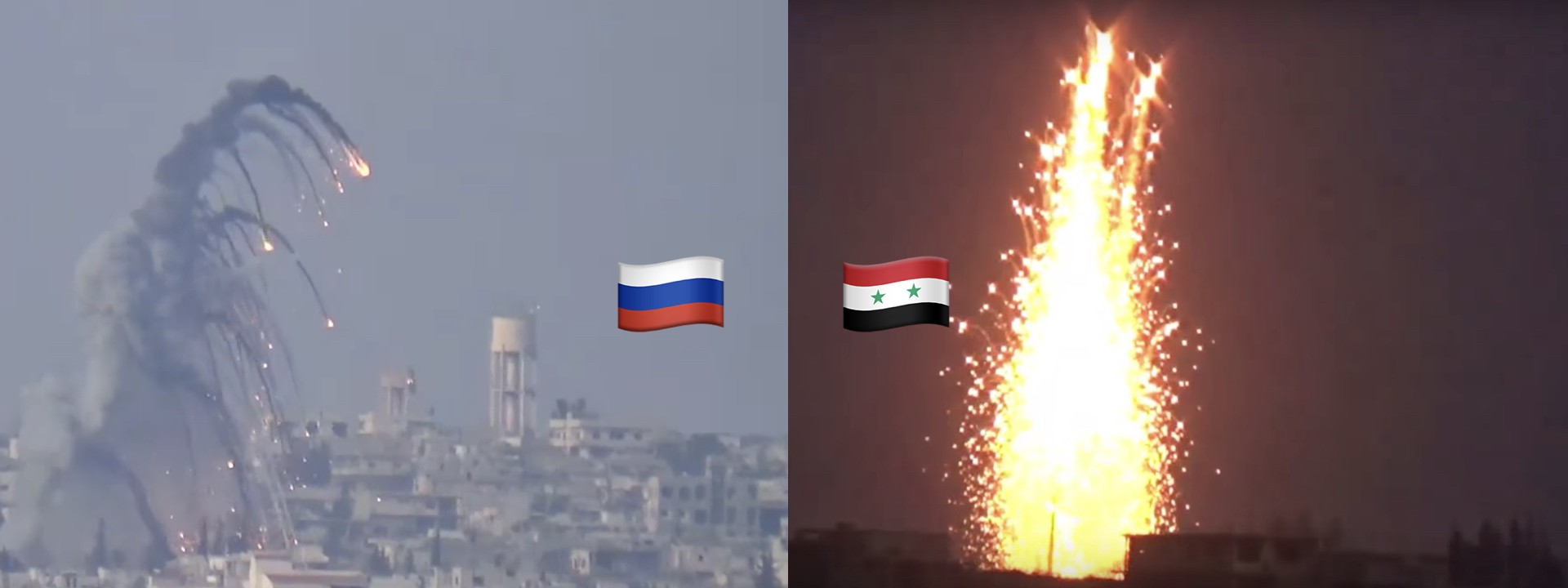#PutinAtWar: Alleged Russian Phosphorus Bombings in Syria
A quick look into alleged Russian attack in Syria, using incendiary weapons
#PutinAtWar: Alleged Russian Phosphorus Bombings in Syria

A quick look into alleged Russian attack in Syria, using incendiary weapons

On December 11, Russian President Vladimir Putin personally visited Syria to publicly announce Russia’s victory against ISIS and military withdrawal from the country. As ISIS-controlled territory in eastern Syria continues to shrink, the Russian military is becoming active elsewhere. @DFRLab previously reported on Russian military engagement in Deir ez-Zor. Now the Russian military is also waging war against Syrian rebels to the west in Hama and possibly using incendiary munitions in the fight.
This is not the first time that Russia was accused of bombing rebel territory or using incendiary munitions in Syria. In fact, RT accidentally exposed RBK-500 ZAB.5SM incendiary bombs mounted on a Russian attack aircraft at a Russian air base in Syria on June 18, 2016.

Two new videos surfaced on YouTube on December 17, allegedly showing Russian jet-fighters dropping incendiary bombs. No public Russian statements were released regarding the mission.
Day Raid
The first video was uploaded on YouTube on December 17, 14:11:50 (UTC) by Syrian STEP News.
The very first images from the video show a Russian Sukhoi Su-25 (NATO reporting name: Frogfoot) jet fighter shooting missiles. At least 12 of Su-25 fighters were deployed in the Khmeimim Air Base this year, and the Syrian Air Force does not possess any.

The location of this video appeared to be in the rebel-held town Al Lataminah.

The bombs dropped by the Su-25 looked similar to forbidden incendiary air-delivered bombs. The exact targets are hard to pinpoint, but the bomb was dropped in the northern part of Al Lataminah.

Night Raid
The second video was uploaded on YouTube on December 17, 15:49:44 (UTC) by Syrian STEP News.
The location of this video appeared to be in the rebel-held town Kafr Zita, only a couple of miles away from Al Lataminah. According to some sources, this area is currently controlled by Hay’at Tahrir Al-Sham rebels.

A water tower in the video suggests that the target hit by the bomb was in the southern part of Kafr Zita.


The video did not capture the aircraft which dropped the bomb, but the explosion correlated near perfectly with the video in Al Lataminah.

Overview
Both targeted areas were in rebel controlled area, northern Hama near the Idlib Governorate.
After detonation, incendiary bombs release small parts of highly flammable chemicals that burn for a prolonged period of time. Incendiary munitions are not designed for precision, but rather to start fires and burn sensitive equipment. The weapon’s use in civilian areas carries a high likelihood of collateral damage.
We cannot be confirm that the bombs depicted in the both videos were actually incendiary, but the type of explosion correlates with those created by incendiary munitions. Bellingcat reported on Russian incendiary bombs used in Syria in 2016 and other reports corroborate other instances in which the Russian military allegedly used these munitions.
Conclusion
The air raids on December 17 were not the first instance of Russia’s alleged use of incendiary munitions.
The Su-25 jet fighter observed in the first video is most likely Russian, since Syrian military does not use these kind of aircrafts. This type of aircraft is mostly used by the ex-Warsaw-Pact countries and Russia itself. There remains no absolute evidence of Russian bombers’ use of incendiary weapons, but the explosions in both recent videos strongly indicate the indiscriminate nature of the weapon in use. Incendiary bombs in civilian areas cause significant collateral damage, and it seems that Russia is not reluctant to use them.
@DFRLab will continue monitoring Russia’s military actions in Syria.
Follow along for more in-depth analysis from our #DigitalSherlocks.

